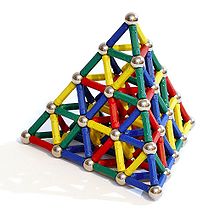
The Volcano:
This is an experiment which can be done individually or as a group.
Material needed:
Trays
Vinegar
Baking Soda
Food Coloring
Popcorn kernels (optional)
Container with spout
Short glass container
The child will scoop a heaping tablespoon of baking soda into a glass container. A short glass or jar, such as a baby food jar, will be conducive to effective overflow. Once the baking soda is in, then in another container with a spout, will hold vinegar and a few drops of food coloring. This a great time to ask the children what they predict will happen. The final step is to allow the child to pour the vinegar mixture into the baking soda. The ingredients will mix together and cause an explosion that will bubble up and out of the container. When the bubbles are gone, the mixture must be emptied before beginning again. Try different shaped vessels for this experiment and adding some popcorn kernels. The kernels will dance inside the mixture, up and down for quite some time.
Making Goop:
This sensory, hands-on experiment involves only three ingredients.Material needed:
Cornstarch
Food coloring
Bowls/Spoon
With this experiment, use a big bowl, or pot for the goop and have another pot of soapy water and a towel nearby for clean up. Alternatively, a sensory table is a great place for goop. Put the cornstarch into a big bowl. First, choose the color by adding a few drops of food coloring to a measuring cup full of water. The key for this mixture is to add the water slowly. If too much water is poured in, there is no turning back until the mixture evaporates over time. When the right amount of water is mixed with cornstarch, the texture will be hard on the bottom, with just a bit of moisture resting on top. When the mixture gets picked up, it will start to run down the fingers: a great goop mess. The goop is easily cleaned. The mixture dries and the corn starch is left and washes off clothes without any hassles. This goop mixture can be left on a shelf and brought back out at a later time. If it hardens, the children can have fun breaking it into little pieces, and then add more water to start enjoying all over again.

Sink or Float
A classic game that does not lose its appeal. Fill the sink or water table with water and allow the children to find safe things that can get wet, or have a number of items chosen. Have a guessing game on whether the item will sink or float ( an apple is always a great choice). To extend this science experiment, find out why things sink or float as well as charting the results into a graph.
Magnet Fun
 Placing out magnets with material to attract, or not, is a fun and safe preschool science set up. Children can explore which items are attracted to magnets and which material are not. They can experiment with placing opposing poles of magnets towards each other and feel the resistence. A great deal of questions, predictions and recordings can be made with magnets. In addition, there are many extended activities with magnets, such as fishing wands and fish, magnet puzzles
Placing out magnets with material to attract, or not, is a fun and safe preschool science set up. Children can explore which items are attracted to magnets and which material are not. They can experiment with placing opposing poles of magnets towards each other and feel the resistence. A great deal of questions, predictions and recordings can be made with magnets. In addition, there are many extended activities with magnets, such as fishing wands and fish, magnet puzzles


